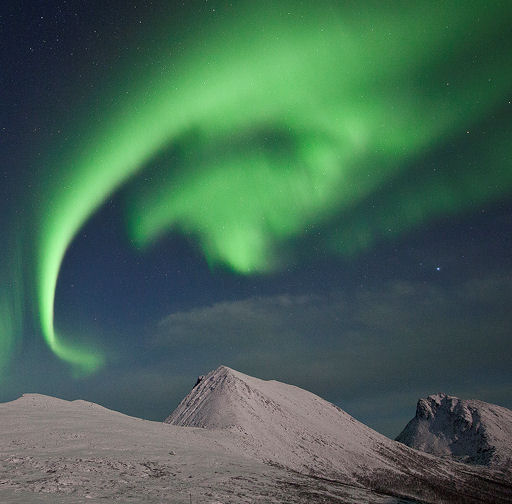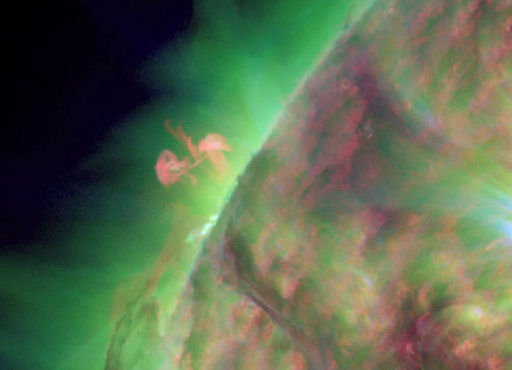SOME COMETS LIKE IT HOT: Astronomers are still scratching their heads over Comet Lovejoy, which plunged through the atmosphere of the sun in December and, against all odds, survived. The comet is now receding into the outer solar system leaving many mysteries behind. [full story] [video]
FRIDAY THE 13TH AURORAS: Who says Friday the 13th is unlucky? Just look how the day began in Tromsø, Norway:
"Friday the 13th started very luckily indeed!" says photographer Antony Spencer. "We enjoyed an incredible display of auroras for five hours. The lights were so bright, even the snow turned green."
The auroras were sparked by the onset of a solar wind stream (~550 km/s), which reached Earth during the early hours of Jan. 13th. More geomagnetic activity is possible tonight as the solar wind continues to blow. Aurora alerts: text, voice.
January 2012 Aurora Gallery
[previous Januaries: 2010, 2009, 2008, 2007, 2005, 2004]
FARSIDE ERUPTION: On Jan. 12th, between 10:00 and 1300 UT, NASA's STEREO-Behind spacecraft observed a significant eruption on the farside of the sun. Although the blast was partially eclipsed by the edge of the solar disk, it nevertheless produced a long-duration X-ray flare (C3-class) detectable from Earth. A movie from NASA's Solar Dynamics Observatory shows some of the debris flying over the NE limb:
The blast site is only ~two days away from rotating onto the Earthside of the sun. By this weekend, we could get a direct look at the active region. Perhaps it will break the recent string of mostly quiet days and low solar activity.
Update: The partially-eclipsed C-flare was strong enough to make waves of ionizaton in Earth's upper atmosphere. This, in turn, disturbed the normal propagation of low-frequency radio waves over Europe. "The C3.3 flare on the far side of the Sun was picked up on my SID monitoring station," reports Dave Gradwell of Birr Ireland. "It affected the 20.9 kHz signal from FTA in France, just before the signal became unstable."

Solar wind
speed: 448.0 km/sec
density: 3.2 protons/cm3
explanation | more data
Updated: Today at 1605 UT
X-ray Solar Flares
6-hr max: C1 1328 UT Jan13
24-hr: C2 0605 UT Jan13
explanation | more data
Updated: Today at: 1600 UT
![]()
Daily Sun: 13 Jan 12
All of these sunspots have simple, quiet magnetic fields. The chance of flares is low. Credit: SDO/HMI
![]()
Sunspot number: 57
What is the sunspot number?
Updated 12 Jan 2012
Spotless Days
Current Stretch: 0 days
2012 total: 0 days (0%)
2011 total: 2 days (<1%)
2010 total: 51 days (14%)
2009 total: 260 days (71%)
Since 2004: 821 days
Typical Solar Min: 486 days
Updated 12 Jan 2012
The Radio Sun
10.7 cm flux: 117 sfu
explanation | more data
Updated 12 Jan 2012
![]()
Current Auroral Oval:
Switch to: Europe, USA, New Zealand, Antarctica
Credit: NOAA/POES
![]()
Planetary K-index
Now: Kp= 1 quiet
24-hr max: Kp= 3 quiet
explanation | more data
Interplanetary Mag. Field
Btotal: 3.9 nT
Bz: 3.8 nT north
explanation | more data
Updated: Today at 1607 UT
![]()
Coronal Holes: 12 Jan 12
A solar wind stream flowing from the indicated coronal hole should reach Earth on Jan. 16-17. Credit: SDO/AIA.





